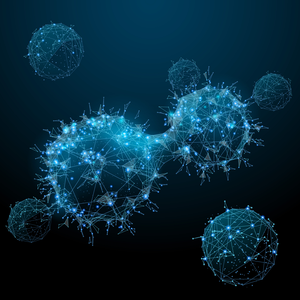
How do cancer cells develop?
The genetic material is the starting point of cancer. When cells multiply, the carriers of the genetic material (the genes) must be transferred to the daughter cell completely, undamaged and free of defects. Otherwise, the daughter cell may be transformed and form cancer cells in this way. However, many circumstances can cause damage to the DNA:
- high-energy radiation, for example from UV light,
- Contact with chemicals,
- aggressive molecules such as radicals, which can damage the cell tissue through oxidation,
- DNA errors during cell duplication, which lead to faulty genetic information,
- Genetic errors that occur in a random way during cell metabolism or cell division,
- infection with oncoviruses increases the risk of developing certain forms of cancer.
What are mutations?
Although smaller cells can repair genetic damage through their repair mechanism, sometimes this damage can still be transferred to the daughter cells during cell division. If the DNA changes permanently as a result, doctors call it a mutation. If there are too many mutations, the healthy cells stimulate a process that leads to the death of the mutations. This process is also called apoptosis and prevents serious genetic damage from being transferred to the daughter cells.
How can mutations lead to cancer genes?
A cell accumulates more and more mutations in its DNA over time. This can cause information to be lost or re-transformed. If the sections of the genetic material that regulate cell growth and division are affected by these processes, cancer can develop. This is also possible through infection with oncoviruses. Here, the oncoviruses introduce new genetic material into the existing genetic material of the host cell and change it, whereby benign cells can transform into tumour cells.
Some of these viruses activate the carcinogenic genes that are already present in the host cell. The following three gene families play a decisive role in this:
- Cancer precursor genes: these include the so-called proto-oncogenes, or cancer genes (oncogenes), which promote cell growth,
- Tumour suppressor genes: these include the so-called tumour suppressor genes, which suppress cell growth
- Repair genes, which repair damage to the genetic material.
Both cancer precursor genes and tumour suppressor genes are responsible for much of the uncontrolled cell proliferation of tumours. The probability of mutations in these types of genes increases with age, which is why the risk of developing cancer also increases with increasing age.
How does a tumour develop?
Tumour development requires at least half a dozen changes in the growth-controlled genes in a cell. There can be very different combinations of gene changes from person to person. Each gene change also gives the individual cancer cells very special properties and abilities. For this reason, cancer cells can be very different in nature and always require very different treatment methods to treat the cancer. While some cancers grow very quickly and aggressively, other cancer cells develop very slowly and usually in secret. In this way, it can happen that the cancer is only diagnosed after years.
How do cancer cells develop? - A summary
Cancer cells develop by changing normal body cells into tumour cells. This happens through cell damage to the genetic material or through errors in reading out the genetic information. But infection with oncoviruses, such as hepatitis viruses, also increases the risk of cancer. Tumour cells multiply uncontrollably when cancer develops and can grow into healthy tissue and also do not die, although they should actually do so. In addition, tumour cells can leave their place in the tissue. Doctors then speak of metastasis.
